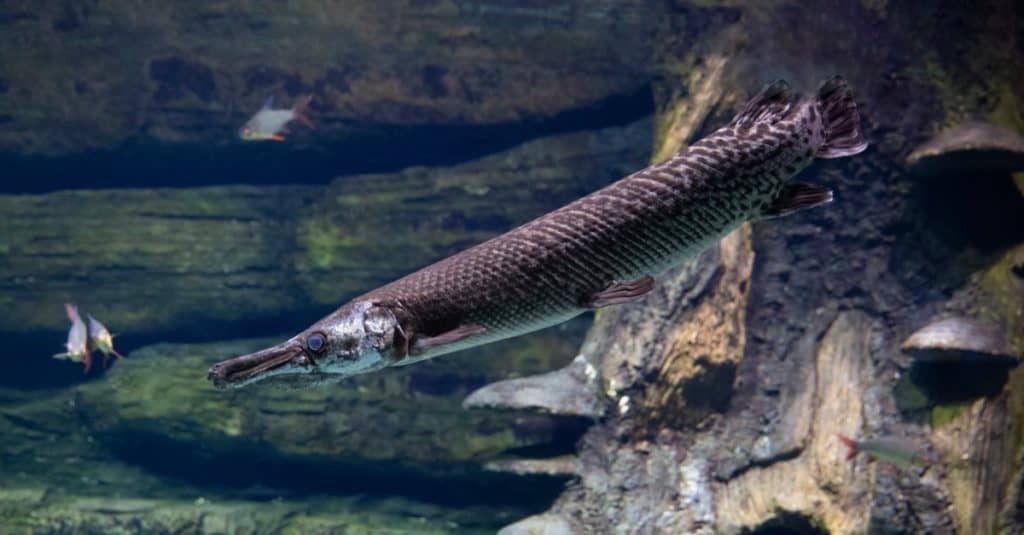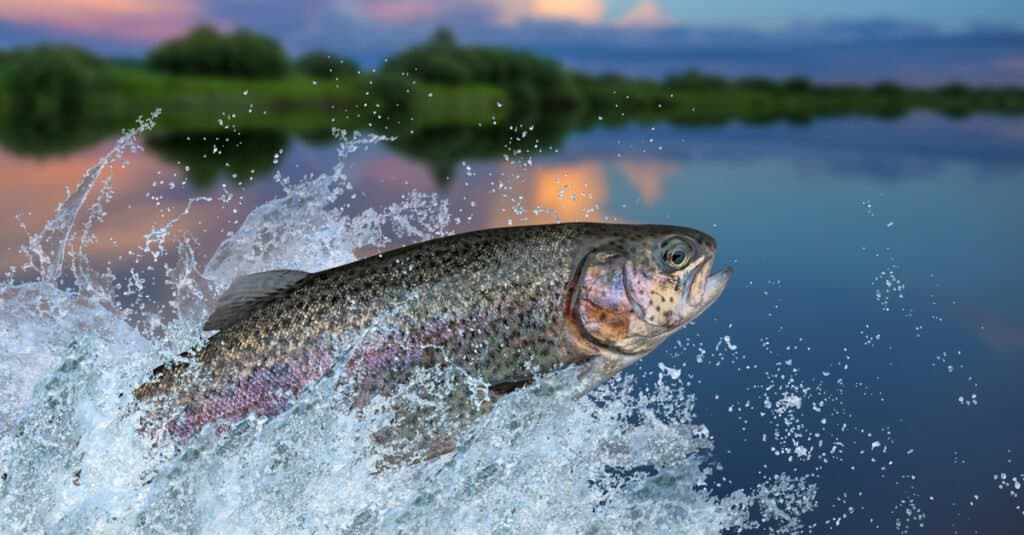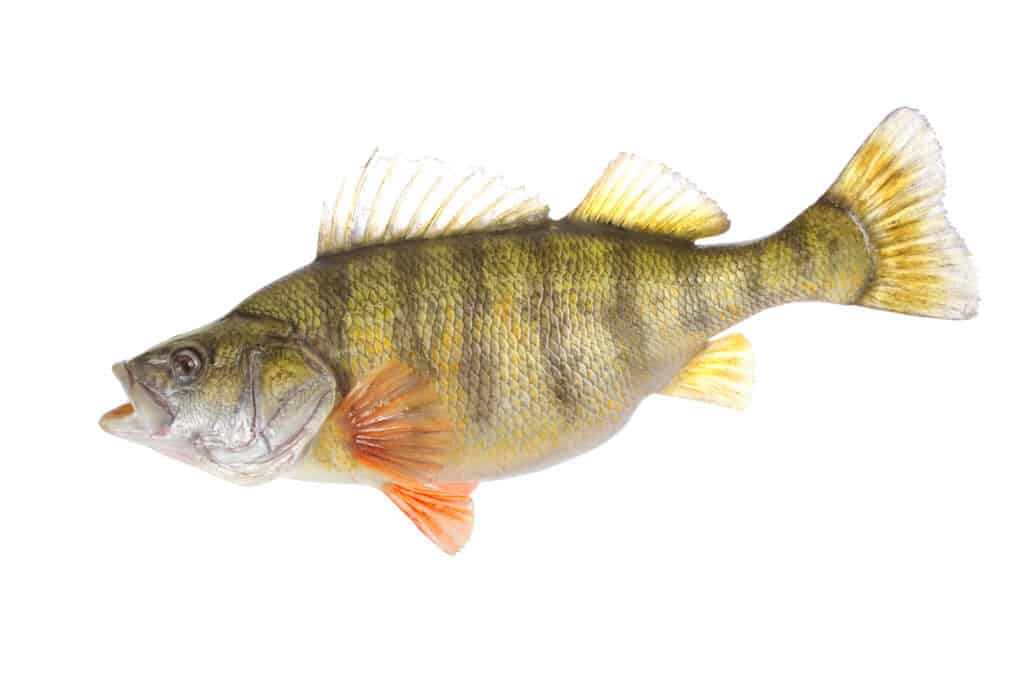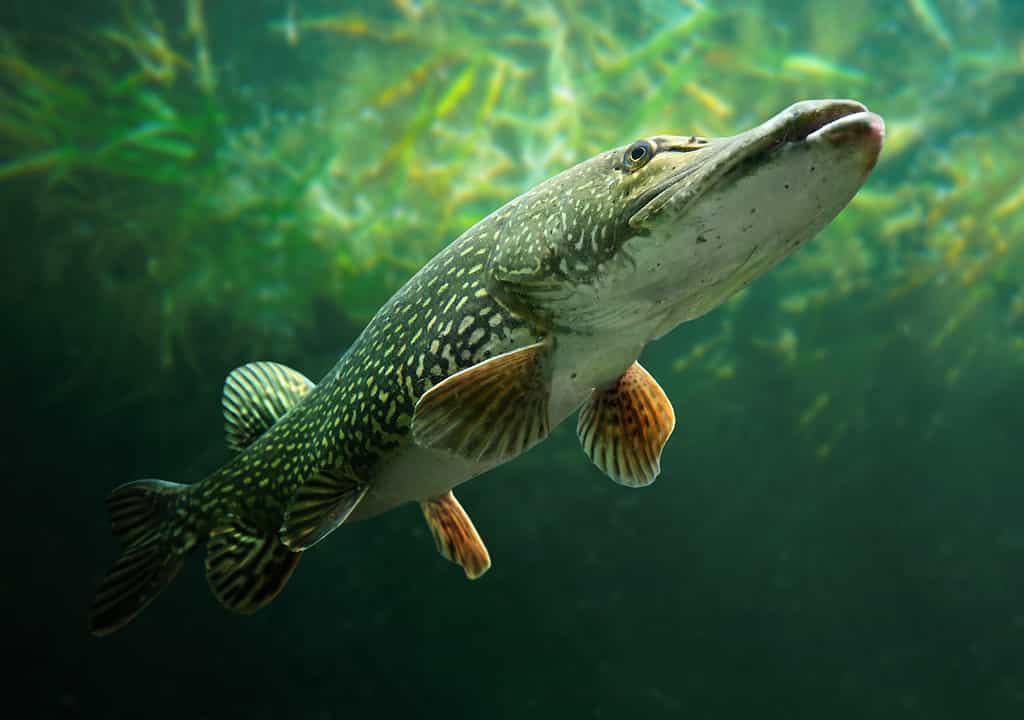Fishing is one of the best activities in Ohio. There is no shortage of rivers, lakes, and ponds. One of the most common fish in Ohio is the longnose gar. They are especially common in Lake Erie and the Ohio River. Some excellent longnose gar fishing spots include the Olentangy River, Big Darby Creek, and Big Walnut Creek. Longnose gar are old and large fish. These prehistoric fish are known to reach impressive lengths of over 5 feet. Follow along to discover the largest longnose gar ever caught in Ohio and the world.
Discover the Largest Longnose Gar Ever Caught in Ohio
Longnose garfish reach impressive lengths and weights. Those in Ohio are no exception. The largest longnose gar ever caught in Ohio weighed 25 pounds. Flora Irvin caught this 49-inch state record in 1966 while fishing in the Ohio River.

The largest longnose gar in Ohio was 49 inches long and weighed 25 pounds.
©iStock.com/User10095428_393
About Longnose Gar
Before we dive into the world record longnose gar, let’s learn more about this impressive and prehistoric animal. Longnose gars are members of the Lepisosteidae family. The genus they long to, Lepisosteus, has been around for about 100 million years old. This unique fish was first officially recorded in 1758. Carl Linnaeus first named this fish species Esox osseus. Not only are longnose gar old fish, but they can also live between 15 to 20 years, although the maximum recorded age of a longnose gar is 39.
Size and Appearance
Longnose gar resembles other gar species. They are long fish, with torpedo-shaped bodies and thick protective ganoid scales. Most longnose gars are brown to green with lighter bellies. Longnose gars are best known for their size and needle-like snout. Their needle-like snout can be up to three times the length of their head or a third of their body length. While longnose gars have sharp cone-shaped teeth, they are harmless to humans. Most of the time, longnose gars are docile and slow-moving.
These impressive fish are also fast growers. During the first year, a longnose gar can grow 20 inches. Most longnose gars reach 2.5 to 4 feet long. However, experts have observed even larger longnose cars exceeding 6 feet long. They can also weigh up to 50 pounds.
Habitat and Distribution
Longnose gars have a wide range. They are native to parts of North America. You can especially find these freshwater slow fish in the southeastern United States. However, they also live in rivers and lakes as far west as Kansas and Texas. Adult longnose gars spend most of their time close to the surface in brackish slow-moving water. They also live in waters with vegetation which they use to hide from predators and hunt.
Diet
So, what do longnose gars eat? These sluggish fish mainly consume fish, crustaceans, and insects. Juvenile longnose gars mainly eat small fish and insects. Their diet changes as they age. Interestingly, the type of fish also depends on their range. For example, longnose gar in Florida, mainly eat bullhead catfish, while shiners are common prey in Missouri.
Predators
Very few animals bother to hunt longnose gars. Although longnose gars seem like easy prey because they spend their time close to the surface of the water and are slow-moving, they are big and have thick armored scales. This can be tough to bite through. Juvenile longnose gars are the most vulnerable. They are sometimes hunted by water snakes, birds, larger fish, and turtles. Although uncommon, American alligators will sometimes eat longnose gars.
The Largest Longnose Gar Caught in the World
Are you curious about the world record longnose gar? It’s about double the size of the largest longnose caught in Ohio. The International Game Fish Association’s all-tackle world record for the largest longnose gar is 43 pounds. On May 7, 2017, Rock Shaw, caught this heavy longnose gar in the Trinity River in Texas. Although the world record, other longnose gars have been recorded weighing up to 55 pounds!

The average weight for a longnose gar is between 30 and 55 pounds.
©ivSky/Shutterstock.com
Other Fish in Ohio
While you can spend your days fishing in lakes, ponds, and rivers in Ohio in hopes of catching a longnose gar, there are plenty of other fish, you can find. Follow along to learn more about other fish species in Ohio.
Smallmouth Bass
Starting our list of fish you can find in Ohio is the smallmouth bass. Smallmouth bass are common throughout the state. You can catch these fish in Lake Erie, Alum Creek Lake, the Ohio River, and the Great Miami River. Smallmouth bass are members of the Centrarchidae family. They are common in the United States and are favorites for most anglers. Smallmouth bass have many nicknames, like brown bass, brownies, and bronzeback. These fish adapt well and live in many different environments including clear rivers, rocky streams, and sandy lakes. In Ohio, the largest smallmouth bass ever caught weighed 9 pounds and 8 ounces. Randy Van Dam caught this 23.5-inch smallmouth bass in Lake Erie in 1993.

Smallmouth bass are common fish in North America.
©Ryno Botha/Shutterstock.com
Rainbow Trout
The next fish on our list is the rainbow trout. This colorful trout is found throughout cold-water tributaries of the Pacific Ocean in Asia and North America. They are common in Ohio. Rainbow trout range in size and color. Some rainbow trout are more vibrant than others, it all depends on the region and subspecies. Rainbow trout are also commonly stocked in non-native reservoirs across the United States. They can weigh as little as 1 pound and as much as 53 pounds. Can you guess the size of the largest rainbow trout caught in Ohio? In 2010, Jason Brooks caught a 38-inch long rainbow trout in Lake Erie. This rainbow trout weighed 21 pounds and 4.8 ounces.

Rainbow trout are commonly found throughout the United States.
©FedBul/Shutterstock.com
Yellow Perch
Yellow perch are also common in North America. These small fish are native to Ohio and you can find them in most rivers, lakes, and ponds. They are most common in slow-moving waters. Yellow perch are golden yellow and grassy green. They range in vividness. They also have light yellow or white bellies. Yellow perch are especially striking for their thick 6 to 8 dark stripes. These bright sport fish are about 0.5 to 1 pound. Although uncommon, they can reach up to 3 pounds. The largest yellow perch in Ohio weighed 2 pounds and 12 ounces. Like the other fish on this list, it was caught in Lake Erie. Charles Thomas caught this Ohio-native fish on April 17, 1984.

Yellow perch are small fish that can weigh as little as 0.5 pounds. The largest yellow perch caught in Ohio weighed 2 pounds and 12 ounces.
©Keith Publicover/Shutterstock.com
Northern Pike
Last but not least is one of the largest fish in Ohio’s waters, the northern pike. They are common fish with a stable population. Because of this, they are listed as Least Concern on the IUCN Red List. Northern pikes are native to the Northern Hemisphere. They aren’t particular about their environment and have a wide range. However, you can mainly find these long fish in sluggish streams. They also live in shallow lakes and rivers with lots of vegetation. Interestingly, northern pikes are aggressive. They’ve been recorded attacking small animals, including ducks and dogs. Although aggressive, they aren’t dangerous to humans. So, how big can a northern pike get in Ohio? The Ohio state record for the largest northern pike is 22 pounds and 6.08 ounces. Chris Campbell caught this giant fish in Lyre Lake in 1988.

Northern pike are common in Ohio.
©iStock.com/abadonian
Thank you for reading! Have some feedback for us? Contact the AZ Animals editorial team.








